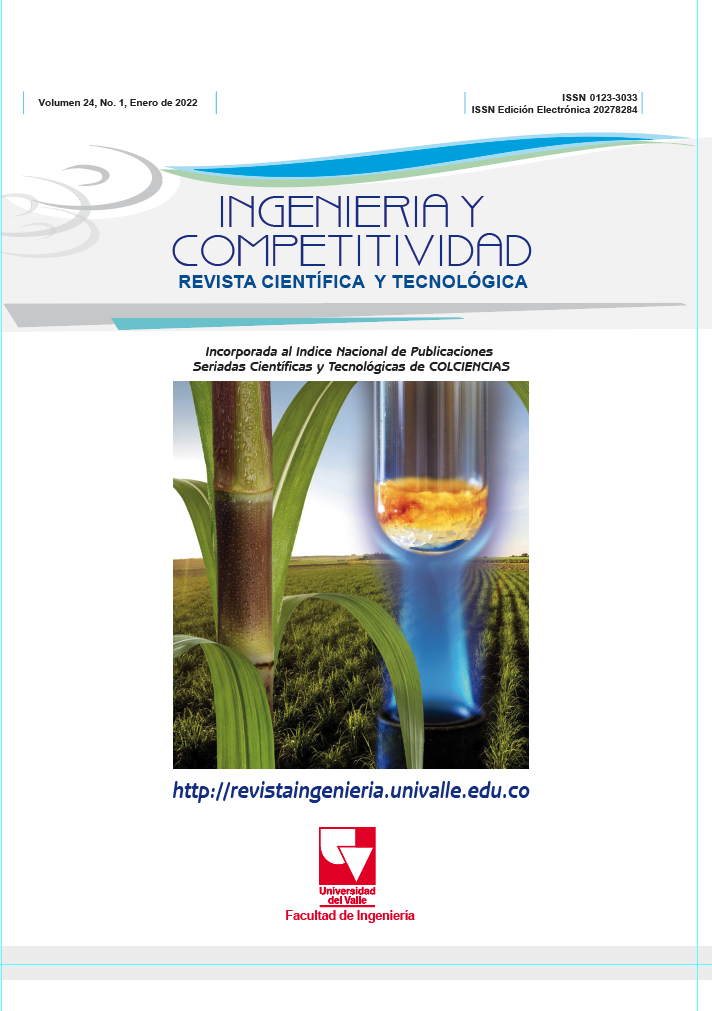Influencia de la pendiente del terreno en los indicadores de cosecha manual de cítricos en el sector agrícola en Caldas-Colombia
Contenido principal del artículo
En Colombia el sector agrícola tiene dificultades en la integración de tecnologías, debido a las dificultades de la topografía, muy característica en la zona de las cordilleras colombianas que pasan por los principales departamentos agrícolas del país y las limitaciones de la capacidad humana ;el proceso de recolección de cítricos se ha hecho tradicionalmente a mano, empleando a miles de personas que no logran rendimientos significativos , provocando así un aumento de los costes de producción con un impacto en los indicadores de cosecha, medidos en términos de calidad y productividad. Este estudio tuvo como objetivo determinar el impacto de las condiciones de la pendiente del terreno en los indicadores de calidad y los indicadores de eficacia, eficiencia y pérdidas, usados para evaluar la productividad del proceso de recolección de naranjas, en un caso de estudio en el Departamento de Caldas-Colombia e identificar así, oportunidades de mejora del proceso. La información sobre el terreno se realizó en fincas productoras de naranja con diferentes pendientes de terreno clasificadas en cuatro categorías. Se logró identificar asociaciones estadísticamente significativas entre los indicadores de eficiencia, eficacia y pérdidas y las condiciones de la pendiente de campo. Además, algunos de estos indicadores mostraron relaciones inversas con el gradiente de pendiente. Por el contrario, la calidad del fruto no se ve afectada por las condiciones de pendiente del terreno.
- Indicadores de cosecha
- Pendiente del terreno
- Proceso de recolección
- Productividad
(1) Miranda-Lasprilla D. Estado actual de fruticultura colombiana y perspectivas de Desarrollo. Rev. Bras. Frutic. 2011;33(Jaboticabal SP):199-205. https://doi.org/10.1590/S0100-29452011000500023
(2) MADR, FNFH, ASOHOFRUCOL, SAG. Plan frutícola Nacional - Diagnóstico y análisis de los recursos para la fruticultura en Colombia [Internet] 2006 [cited 2019 Nov 25]. Available from: https://repository.agrosavia.co/handle/20.500.12324/12401
(3) Frutas, el nuevo camino exportador. Revista Semana [Internet] 2015 Jun 22 [cited 2019 Dec 12] Available from: https://www.semana.com/pais/articulo/exportaciones-colombianas-fruta/209741/
(4) Escobar M. Cadena de los cítricos en Colombia. Manizales: Ministerio de Agricultura y Desarrollo Rural [Internet] 2014 [cited 2020 may 23]. Available from: http://www.citricaldas.com.co/wp-content/uploads/Cadena-Citricos-Manuel-Escobar-Quijano-Sep-24-2014.pdf.
(5) López AF. Manual para la preparación y venta de frutas y hortalizas: del campo al mercado [Internet]. Roma: Boletin de servicios agrícolas de la FAO; 2003 [cited 2020 Feb 12] Available from: http://www.fao.org/3/Y4893S/Y4893S00.htm
(6) FAO. Guía para la descripción de suelos [Internet]. 4th ed. Rome: FAO; 2009. 111 p. Available from: http://www.fao.org/3/a0541s/a0541s.pdf.
(7) Rodriguez E, Sandoval J, Chapparro J, Trejos G, Medina E, et al. Guía metodológica para la zonificación de amenaza por movimientos en masa escala 1:25.000 [Internet]. Bogotá: Servicio Geológico Colombiano; 2017. 217 p. [cited 2020 Jan 28]. Available from: https://www2.sgc.gov.co/Archivos/GM(2017).pdf
(8) Khormali F, Ajami A, Ayoubi S, Srinivasarao C, Wani S. Role of deforestation and hillslope position on soil quality attributes of loess-derived soils in Golestan province, Iran. Agric. Ecosyst. Environ.2009;134:178–189. https://doi.org/10.1016/j.agee.2009.06.017.
(9) Wang Y, Zhang XC, Zhang JL, Li SJ. Spatial variability of soil organic carbon in a watershed on the loess plateau. Pedosphere. 2009;19:486–495. https://doi.org/10.1016/S1002-0160(12)60026-5
(10) Paz-Kagan T, Ohana-Levi N, Herrmann I, Zaady E, Henkin Z, Karnieli A. Grazing intensity effects on soil quality: a spatial analysis of a Mediterranean grassland. Catena. 2016;146:100–110. http://dx.doi.org/10.1016/j.catena.2016.04.020
(11) Poje A, Potočnik I, Košir B, Krč J. Cutting patterns as a predictor of the odds of accident among professional fellers. Safety science. 2016;89:158-166. https://doi.org/10.1016/j.ssci.2016.06.011
(12) Yoshida M, Sakai H. Winch Harvesting on Flat and Steep Terrain Areas and Improvement of its Methodology. Croat. j. for. Eng. 2015;36(1):55-61. Available from: http://www.crojfe.com/archive/volume-36-no-1/winch-harvesting-on-flat-and-steep-terrain-areas-and-improvement-of-its-methodology/
(13) Strandgard M, Alam M, Mitchell R. Impact of Slope on productivity of a self-leveling processor. Croatian Journal of Forestry Engineering. 2014;35(2):193-200. http://www.crojfe.com/archive/volume-35-no-2/impact-of-slope-on-productivity-of-a-self-levelling-processor/
(14) Panizzoni G, Magliocchetti D, Prandi F, De Amicis R. Interactive virtual planning tools for sustainable forest production in mountainous areas. In: Stephanidis C. eds. HCI International 2015 - Posters' Extended Abstracts. HCI 2015. Communications in Computer Science and Information Sciences, vol 528. Springer, Cham. https://doi.org/10.1007/978-3-319-21380-4_39.
(15) Santinato F, Pereira R, De Albulquerque V, Da Silva C, De Olivera T. Mechanical harvesting of coffee in high slope. Catinga. 2016;29(3):685-691. https://doi.org/10.1590/1983-21252016v29n319rc
(16) Cadena G. Engineering and Agro. Revista de Ingeniería. 2011;33:70-87. https://doi.org/10.16924/revinge.33.8
(17) Oliveros C, Sanz J. Ingeniería y café en Colombia. Revista de Ingeniería.2011. 33:99-114. http://dx.doi.org/10.16924%2Friua.v0i33.183.
(18) Cortes E, Alvarez F, Gonzalez H. La mecanización agrícola: gestión, selección y administración de la maquinaria para las operaciones de campo. Revista CES Medicina y Veterinaría. 2009;4(2):151-160.
(19) DANE. El cultivo de la naranja Valencia (Citrus sinensis [L.] Osbeck) y su producción como respuesta a la aplicación de correctivos y fertilizantes y al efecto de la polinización dirigida con abeja Apis mellifera [Internet]. DANE. 2016. [cited 2020 Apr 24] Boletín mensual, no.52. Available from: https://www.dane.gov.co/files/investigaciones/agropecuario/sipsa/Bol_Insumos_oct_2016.pdf.
(20) FAO. The State of Food and Agriculture 2017. Leveraging food systems for inclusive rural transformation [Internet]. FAO. 2017 [cited 2020 Dec 12] Available from: http://www.fao.org/policy-support/resources/resources-details/en/c/1046886/
(21) Vélez J, Montoya E, Oliveros C. Estudio de Tiempos y Movimientos para la Cosecha Manual de Café [Internet]. Chinchiná: CENICAFÉ. 1999. [cited 2020 Nov 13]. Boletín Técnico No. 21. Available from: http://hdl.handle.net/10778/593
(22) Carvalho CPP, Navarro P, Salvador A. Poscosecha. In: Cítricos: Cultivo, Poscosecha e Industrialización [Internet]. 1st ed. Caldas: Corporación Universitaria Lasallista; 2012. p. 233–84. Available from: http://repository.lasallista.edu.co/dspace/bitstream/10567/452/1/citricos.pdf.
(23) León G, Roy A, Choudhary N, Brlansky R. Transmisión de leprosis de los cítricos por ácaros Brevipalpus yothersi a través de hospederos no cítricos. Corpoica Cienc Tecnol Agropecuaria. 2017;18(2):307-319. http://dx.doi.org/10.21930/rcta.vol18_num2_art:633
Descargas

Esta obra está bajo una licencia internacional Creative Commons Atribución-NoComercial-CompartirIgual 4.0.
Los autores que publican en esta revista están de acuerdo con los siguientes términos:
Los autores ceden los derechos patrimoniales a la revista y a la Universidad del Valle sobre los manuscritos aceptados, pero podrán hacer los reusos que consideren pertinentes por motivos profesionales, educativos, académicos o científicos, de acuerdo con los términos de la licencia que otorga la revista a todos sus artículos.
Los artículos serán publicados bajo la licencia Creative Commons 4.0 BY-NC-SA (de atribución, no comercial, sin obras derivadas).





